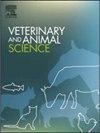Improved growth performance and meat tenderness in jersey steers weaned at 60 days and fed a high-energy forage-free diets
IF 1.9
Q2 AGRICULTURE, DAIRY & ANIMAL SCIENCE
引用次数: 0
Abstract
The performance, carcass characteristics, and meat quality of Jersey male calves in feedlots were evaluated to determine the optimal feeding program and weaning age for improved growth performance and meat quality. Jersey male calves were paired according to birth and weaned at either 30 or 60 days of age. They were then assigned to one of two feeding groups, both receiving high-energy, isonitrogenous total mixed rations (TMR): a high-grain diet containing 12% forage and 47 % neutral detergent fiber (NDF), or a forage-free diet with 0% forage and 17% NDF. Average Daily Gain (ADG) was evaluated for 265 days after TMR adaptation. All data were analyzed using a completely randomized design in a 2 × 2 factorial arrangement, evaluating two main effects and their interaction. ADG was higher when steers were weaned later (0.923 vs. 0.829 kg/d, P < 0.05). Dry matter intake was higher in steers fed the high-grain diet compared to those fed the forage-free diet (3.21 vs. 2.71% BW, P < 0.05). Feed efficiency was higher in calves weaned at 30 days and fed the forage-free diet (0.27 vs. 0.21 kg/kg, P < 0.05). Tenderness of the Longissimus dorsi muscle, measured after 24 h at 2 °C using Warner–Bratzler shear force, tended to be improved in calves weaned at 60 days and fed the forage-free diet (3.91 vs. 4.27 kg, P < 0.10), as well as a trend for increased backfat thickness in calves weaned at 30 days and fed the forage-free diet (4.2 vs. 3.5 mm, P < 0.10). No significant effects of weaning age or diet were observed on dressing percentage, color parameters, marbling, cooking loss, or LMA (P > 0.10). Rump steak weight was significantly reduced in steers weaned at 30 days and fed a forage-free diet (1.606 vs 1.768 kg, P < 0.05), whereas no effect was observed in steers weaned at 60 days. In conclusion, male Jersey calves weaned at 60 days achieved average daily gains exceeding 0.900 kg, showed greater feed efficiency, and tended to produce more tender meat when fed a forage-free diet, which may result in improved overall meat quality.
提高60日龄断奶泽西阉牛的生长性能和肉质嫩度
通过对泽西雄性犊牛生产性能、胴体特性和肉品质的评价,确定提高泽西雄性犊牛生长性能和肉品质的最佳饲喂方案和断奶年龄。按出生配对,分别在30日龄和60日龄断奶。各组分别饲喂高能量等氮全混合日粮(TMR):高粒饲粮(含12%饲料和47%中性洗涤纤维)和无饲料饲粮(含0%饲料和17%中性洗涤纤维)。TMR适应后265 d计算平均日增重(ADG)。所有数据采用2 × 2因子排列的完全随机设计进行分析,评估两个主要效应及其相互作用。断奶越晚,平均日增重越高(0.923 vs. 0.829 kg/d, P <;0.05)。高粒饲粮的干物质采食量高于无料饲粮(3.21比2.71%)。0.05)。饲喂无饲料日粮的30日龄断奶犊牛饲料效率较高(0.27 vs 0.21 kg/kg, P <;0.05)。使用Warner-Bratzler剪切力在2°C下加热24 h后测量的背最长肌压痛,在60天断奶并饲喂无饲料的犊牛中有改善的趋势(3.91比4.27 kg, P <;0.10),以及30日龄断奶和饲喂无料日粮的犊牛背膘厚度增加的趋势(4.2 vs. 3.5 mm, P <;0.10)。断奶年龄或日粮对屠宰率、颜色参数、大理石花纹、蒸煮损失或LMA没有显著影响(P >;0.10)。30日龄断奶、饲喂无饲料日粮的阉牛臀肉重量显著降低(1.606 vs 1.768 kg, P <;0.05),而对60日龄断奶的阉牛无影响。综上所述,60日龄断奶泽西雄性犊牛平均日增重超过0.900 kg,饲料效率更高,肉质更嫩,整体肉质可能得到改善。
本文章由计算机程序翻译,如有差异,请以英文原文为准。
求助全文
约1分钟内获得全文
求助全文
来源期刊

Veterinary and Animal Science
Veterinary-Veterinary (all)
CiteScore
3.50
自引率
0.00%
发文量
43
审稿时长
47 days
 求助内容:
求助内容: 应助结果提醒方式:
应助结果提醒方式:


